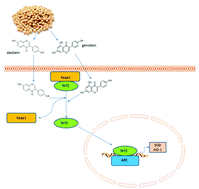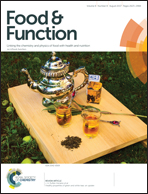Soybean isoflavones ameliorate ischemic cardiomyopathy by activating Nrf2-mediated antioxidant responses
Abstract
Ischemic cardiomyopathy (IC) is the major cause of heart failure. Conventional medicine has been proved ineffective with adverse effects. Soybean presents exciting adjunctive therapies and shows protective benefits for IC. However, the molecular mechanisms remain unclear. Isoflavones are the main bioactive components of soybean and may be protective against heart disease. Isoflavones were extracted by using an acidic-ethanol method and analyzed by HPLC. All patients with ischemic stroke were randomly and evenly assigned to two groups: the isoflavone group (80 mg day−1, n = 100) and control group (80 mg day−1 placebo, n = 100), and the whole period of the experiment was 24 weeks. The effects of soybean isoflavone on brachial flow-mediated dilatation (FMD) were measured. HPLC fractionation shows that isoflavone extracts are mainly composed of 55% genistein, 23% daidzein, and 14% glycitein. Isoflavone therapy reduced more levels of triglyceride and LDL-c in females than in males. FMD was higher in the isoflavone group than in the control group after 24-week therapy (treatment effect 2.0%, 95% CI 0.18–3.0, P = 0.01). The baseline differences were adjusted in FMD and the isoflavone therapies were closely associated with the reduction of FMD impairment at 24 weeks (odds ratio 0.30, 95% CI 0.14–0.85, P = 0.01). The effects of isoflavone on brachial FMD were negatively associated with base FMD (r = −0.65, P < 0.01). Furthermore, isoflavone therapy caused a significant increase in the levels of erythroid-derived 2-like 2 (Nrf2), superoxide dismutase (SOD) and a significant decrease in serum levels of C-reactive protein, 8-isoprostane, malondialdehyde, interleukin-6 and tumor necrosis factor alpha. In contrast, the isoflavones had no effects on the levels of oxidation-related molecules when Nrf2 was silenced. These results suggest that soybean isoflavones ameliorate IC patients by improving their antioxidant capacities via the upregulation of Nrf2.



 Please wait while we load your content...
Please wait while we load your content...